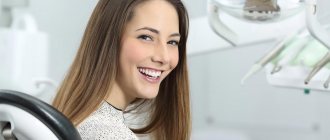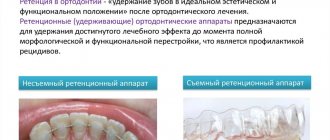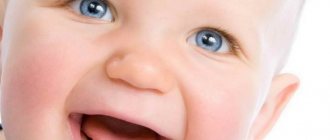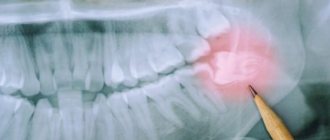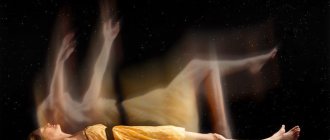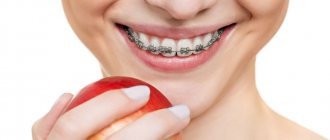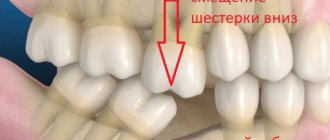From childhood we are taught to keep our back straight and are regularly checked for spinal curvature. However, they never explain why this is necessary. Perhaps if we understood the importance of posture for the entire body, it would be easier for us to monitor the straight position of our back without constantly shouting: “Hold your back!”
Most people are unaware of the relationship between posture and teeth. And no wonder, because there is little accessible and understandable information about this.
Meanwhile, it has been proven that incorrect posture leads to problems with joints and malocclusion. Feedback also works: bite affects posture.
Have you ever wondered what correct posture and a healthy back mean for a person?
Straight teeth and a healthy back: is there a relationship?
The importance of correct posture
In the 21st century, people spend most of their time sitting. We go to work sitting, work sitting, have lunch sitting, spend our leisure time sitting. And most likely, you are reading this text while sitting. It is not surprising that our body and posture in particular begin to adapt to a sitting position.
However, the optimal sitting posture for a modern person is a test for our musculoskeletal system. In this position, posture suffers the most. The need to sit for long periods of time causes serious back problems.
The importance of correct posture
What is posture?
Posture is a body position that is comfortable for a person when moving and at rest. A person takes this position unconsciously, relaxing, when he is not taking care of himself. There is even a special term for this - “motor stereotype”.
Posture consists of three components:
- muscles,
- ligaments,
- bone frame.
The body is held in space by the muscular system. Relying on gravity, the muscles build up the optimal vertical position of the body from the sections (head, chest, torso, pelvis, legs). To conserve energy, our body itself strives to take a position that does not require effort from the muscles.
A correctly aligned position of the body in space does not place a load on the ligamentous apparatus - and this is good, because ligaments are not capable of prolonged tension.
It is equally important that the load on the skeletal frame should be directed strictly along the spinal column. Otherwise, deformations in the bone structures will inevitably occur.
Violation at any of these levels leads to problems and is accompanied by back pain. However, the bone frame has a special role.
What is posture?
Skeletal structure: basics of osteology
The human skeleton is the collection of all the bones. There are an axial part (skull, spine, chest) and an accessory part (arms and legs). That is, in fact, the skull and spinal column are the main axis of the human body.
The spinal column consists of 32-33 vertebrae and has an S-shape due to bends:
- Cervical lordosis is a forward bend in the cervical spine,
- Thoracic kyphosis - backward bending in the thoracic region,
- Lumbar lordosis is a forward bend in the lumbar region,
- Sacral kyphosis is a backward bend in the sacrum.
Thanks to these bends, the spine absorbs the load, compressing and straightening like a spring. This helps prevent injury to the intervertebral discs and ligaments due to excessive load on the spinal column. The spine is involved in the movements of the head and is connected to the skull through several joints.
Skeletal structure: basics of osteology
Structure of the maxillofacial region and bite
At the top of the spinal column is the skull. In humans, the skull consists of 23 bones, connected to each other by bone sutures and one paired temporomandibular joint. This joint is extremely important: it fixes the lower jaw to the upper and is involved in the bite.
Occlusion is the nature of the closure of the dentition with the most complete contact of all teeth. The bite begins to form in early childhood - during the eruption of baby teeth. A dentist can detect problems with teeth closing as early as 5-6 years of age.
According to statistics, about 78% of children in the Republic of Belarus have an incorrect bite. What does this mean? In addition to affecting facial aesthetics and the processes of chewing, swallowing and breathing, malocclusion leads to problems with posture.
The tendency to consider occlusion separately from the musculoskeletal system is now outdated. It’s not news at all that the human body is an integral and balanced system. And bite is part of bone balance. An imbalance in the relationship of the jaws causes a chain reaction of imbalance in some other part of the spinal column or joints of the limbs.
Structure of the maxillofacial region and bite
General conditions
Existing or past diseases manifest themselves in the form of various inflammations and diseases of the oral cavity, teeth and gums.
- If in childhood you suffered from severe flu or measles, then in adulthood this can result in diseases of the periodontium (periodontitis, periodontal disease) and teeth (pulpitis).
- If your body suffers from a lack of water or it is difficult to remove it from the body, do not be surprised by bleeding and gum inflammation.
- Vitamin deficiencies, especially a lack of vitamin C, are the cause of loosening and even tooth loss.
- Diseases of the gastrointestinal tract manifest themselves in the form of a whitish coating on the tongue, cracks and inflammation of the tongue.
Other negative consequences of tooth loss
Other consequences of tooth loss include:
- Development of caries. Due to the loss of a tooth, neighboring teeth can mix and take on an abnormal position, and hard-to-clean areas can form where food easily gets in, causing decay processes, the formation of caries and provoking other dental diseases.
- Weakening of other teeth. Due to the absence of one tooth, the load on other teeth increases. Accordingly, the fewer the teeth, the greater the load they are exposed to, and this leads to their weakening.
- Halitosis (bad breath). When teeth are lost, the local periodontal tissue is destroyed, becomes inflamed, and then develops into periodontitis, which, without timely treatment, often leads to an abscess and bad breath.
- General weakening of the immune system.
- The need to diet. If a patient has lost several teeth, this can negatively affect his diet, as he often has to give up solid foods.
- Deterioration in appearance. Even the loss of one tooth can affect a person's appearance and lead to self-doubt.
Each organ has its own tooth
It has been known since ancient times that the condition of a particular tooth can determine the disease in the corresponding group of organs. Today this is a scientifically proven fact. For example, by using the incisors above and below (teeth 1 and 2), diseases of the ears, bladder and kidneys can be diagnosed, and by the canines (3) the condition of the liver and gallbladder can be determined. Small molars (premolars 4 and 5) transmit data about the lungs and large intestine, and large molars (molars 6 and 7) about the stomach, spleen and pancreas, and the so-called “wisdom teeth” can tell about the condition of the heart and small intestine .
At the same time, affected teeth identified by a dentist during an examination do not always mean the presence of diseases in the corresponding internal organs. It happens that a patient presents with pain in apparently healthy teeth or even with phantom pain (a painful signal comes from an internal organ to the site of the extracted corresponding tooth). Knowing about these relationships, it is easier to identify the affected organs.
Name of human teeth
Depending on the location and structure, dental units have their own functional characteristics and are called differently.
- Incisors.
On both jaws there are four front teeth in humans - medial and lateral incisors, which are used for biting food. - Fangs.
Sharp teeth designed for chewing hard foods. - Premolars.
"Fours" and "fives" on the left and right sides of each jaw arch grind soft or small pieces of food. - Molars.
Three large outer teeth in each row are aimed at grinding coarse substances. - The canines
and incisors are part of the anterior group, or the “smile zone,” and the human molars are part of the chewing segment.
In addition, teeth are divided into temporary and permanent. In the first case, we are talking about dairy products that appear in children from the fifth month of life to three years. The second refers to the final bite, which is formed between six and thirteen years of age. Milk teeth differ from permanent teeth only in size, but in structure they are identical.
Pain is a good signal
The connection between internal organs and teeth and the oral cavity is evidenced by medical statistics on patient treatment accumulated over many years. For example, bad teeth can be a source of headaches. Damage to molars - there is pain in the parieto-occipital region. A source of infection in the maxillary incisors can lead to pain in the frontotemporal region, and from diseased canines the pain can be concentrated in the temporal region. If you have problems with the teeth of the lower jaw, a migraine may develop, and it can only be alleviated by visiting a dentist.
Painful sensations in the upper and lower incisors are a reason to get checked for cystitis, otitis media, or treat chronic pyelonephritis. Pain in the first incisor is a possible syndrome of prostate adenoma, frontal sinusitis, tonsillitis, prostatitis, osteochondrosis. Aching pain in the fangs is possible with hepatitis or cholecystitis.
Chronic pneumonia can be diagnosed by pain in the 4th and 5th molars. The same focus of pain indicates colitis, advanced dysbacteriosis, an allergic reaction (rhinosinusitis, bronchial asthma, respiratory allergosis).
The influence of posture on bite
The reverse relationship is also true: just as the bite affects posture, posture can significantly change the bite.
There are some children in whom an experienced orthodontist can recognize an incorrect bite right from the start. Their posture gives them away. Scoliosis and anteroposterior curvatures of the spine (kyphosis and lordosis) lead to the formation of a so-called crossbite - when the lower lateral teeth overlap the upper ones from the outside, buccally. The second type of cross-relationship is a scissor-type bite: the lateral upper teeth stand wide and slide over the lower ones without contacting the tubercles. Chewing efficiency with such a bite decreases significantly.
In addition, patients with scoliosis more often develop distal occlusion - a dental pathology in which the upper jaw protrudes forward.
If we talk about the development of the maxillofacial region as a whole, a clear connection has been established between scoliosis and a decrease in the size of the skull and jaws.
In 98% of cases in patients with scoliosis, the dental arches develop asymmetrically. And the more serious the spinal deformity, the more pronounced the asymmetry of the face.
An orthodontist who is fully aware of the structural integrity of the body will definitely recommend visiting a posture correction specialist.
The influence of posture on bite
A dental problem is not just a dental problem
Pain in the quads above and below can be a sign of weak ligaments (shoulder, elbow, wrist, ankle and knee joints), chronic inflammation of the joints (for example, polyarthritis), diseases of the large intestine - diverticulosis, polyposis.
Sixes and sevens (molars) are beacons of gastrointestinal diseases (gastritis, gastric or duodenal ulcers), advanced anemia, chronic pancreatitis. Problems with the top six are a reason to get checked for tonsillitis and sinusitis, diseases of the pharynx and larynx, tumor formations in the thyroid gland, mastopathy, and inflammation of the appendages. If something is wrong with the lower sixes, there are problems with the arteries, atherosclerosis. But the lower sevens are problems with the lungs (chronic pneumonia, bronchitis, bronchial asthma), polyps in the large intestine, something is wrong with the veins (varicose veins, hemorrhoids).
Have your wisdom teeth been bothering you for a long time? Make an appointment not only with the dentist, but also with the cardiologist. Coronary heart disease, congenital heart disease and other cardiac diseases - in terms of wisdom teeth. Plaque and tartar can be a signal of endocrine system disorders, a sign of gastric ulcer.
Network of dental clinics KANO and physical therapy clinic KANO
The human body is an inexpressibly complex system. Everything is closely intertwined in it, even if the relationship does not seem obvious at first glance. Therefore, qualified treatment and recovery require an integrated approach from thinking doctors of different specialties. Such a unique concept can be found in Minsk in the KANO network of dental clinics and the KANO physical rehabilitation clinic.
Dentists of the KANO clinic network will provide comprehensive treatment for dental problems of any complexity: from professional oral hygiene to high-tech digital prosthetics and Zygoma zygomatic implantation.
Physical Therapy Clinic KANO
And at the KANO physical therapy clinic, specialists will offer you a comprehensive program for posture correction and joint rehabilitation, which includes physical therapy and therapeutic exercises, physiotherapy, kinesiotherapy and massage. A holistic approach brings full results!
On a note
You should not go to extremes and see any toothache as a serious disease of the internal organs. It could be ordinary caries and nothing more. After all, the cause of caries can be many different or a combination of several factors: past infectious diseases, stress, lack of microelements, metabolic disorders.
The listed symptoms only indicate that different systems of the body are interconnected. Moreover, this connection can also be the opposite: an infection from a diseased tooth can easily be transferred into the body with food and saliva. Damages often affect the cardiovascular system (increased blood pressure), the excretory system (the appearance of trophic skin disorders, increased sweating), and in some cases the nervous system.
During inflammatory processes in the teeth (caries, pulpitis), pain appears so acute that the person immediately grabs the pills and the pain goes away. It turns out that the signal from the diseased organ was never noticed. And the process of destruction does not slow down, foci of chronic infection arise, which can be a source of more serious disorders in the body (sometimes this can even result in a heart attack, meningitis, sinusitis). In order for the body to work smoothly, you need to contact the dentist in a timely manner. And at the same time, we should not forget that after treating a diseased tooth, it is advisable to examine the organs associated with it.
Dentistry and physical rehabilitation: relationship
The concept of osteopathic dentistry should not be overlooked when treating teeth.
What does it mean? During orthodontic treatment, in one hundred percent of cases, the position of the teeth changes and, accordingly, the contacts between the teeth. At the same time, the vector of application of chewing forces and the distribution of chewing load change. That is, after treatment we get a completely different bite.
Correcting the bite without concomitant treatment of postural disorders by an orthopedist will lengthen the time it takes to straighten teeth and increase the likelihood of relapse - that is, the return of teeth to their original uneven position.
We have the same effect with total prosthetics and reconstruction of all teeth using All-on-4/6 technology. After treatment, the jaw relationship, muscle tone and position of the temporomandibular joint changes dramatically. Do you think such dental intervention will affect other parts of the skeletal system?
The balance of forces changes, and skeletal structures will strive to restore balance, often at the expense of healthy joints. After all, the body has already developed its balance over many years and adapted. It may not have been entirely aesthetically pleasing or symmetrical, but it was a balance.
Therefore, after correcting the bite and aligning the “Hollywood”, the problem may arise from an unexpected front - in the form of back pain, for example.
There is also the other side of the coin: it is impossible to correct your posture without making changes to the blocked malocclusion. You can go to massage therapists and kinesiotherapists for years, get temporary relief and wonder why the pain comes back. And the answer is on the surface - you need to pay attention to correcting the bite.
Dentistry and physical rehabilitation: relationship
Complex treatment in combination of methodologies
After reading this article, you understand why the cooperation of a competent orthodontist and an orthopedic rehabilitation specialist is important when correcting spinal curvatures and crooked teeth.
If you look from the position of osteology, ignoring problems with posture leads not only to aesthetic problems. Disorders in the musculoskeletal system lead to osteochondrosis, radiculitis and other diseases of the spine.
At the same time, from the dental side, malocclusion threatens problems with the temporomandibular joint, pain in the teeth, gum and periodontal diseases, abrasion and loosening of teeth, and a high level of caries.
And if we take into account that these problems complement and mutually aggravate each other, it becomes crystal clear that they need to be treated comprehensively. An orthopedist-rehabilitator should participate in the restoration of the bite along with an orthodontist, and in parallel with the correction of posture, teeth should be restored.
Complex treatment in combination of methodologies
How to prevent tooth loss
Prevention of tooth loss includes:
- daily dental care (thorough brushing, flossing, etc.);
- timely treatment of teeth and oral problems;
- timely dental examinations every six months (help to identify oral diseases in the early stages);
- good nutrition (the daily diet should include vegetables, fruits, lean meat and foods rich in calcium);
- gum massage (to improve blood circulation);
- timely restoration of lost teeth (reduces the load on neighboring teeth).
Thus, oral health is linked to overall body health, and dental treatment can reduce the risk of developing cardiovascular disease in the future. Make an appointment with your dentist and undergo a preventive examination, because early detection of the disease is the key to successful treatment!
